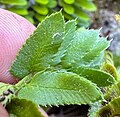
Polystichum munitum, the western swordfern, is an evergreen perennial fern native to western North America, where it is one of the most abundant ferns in forested areas. It occurs along the Pacific coast from southeastern Alaska to southern California, and also inland east to southeastern British Columbia, northern Idaho and western Montana, with disjunctive populations in northern British Columbia, Canada; the Black Hills in South Dakota, United States; and Guadalupe Island off of Baja California, Mexico. Western swordfern is known to have locally naturalized in parts of Great Britain and Ireland.
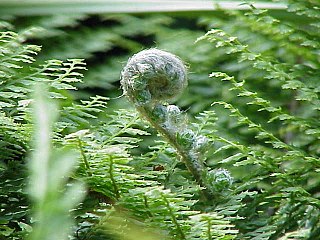
Polystichum setiferum, the soft shield fern, is an evergreen or semi-evergreen fern native to southern and western Europe. The stalks and most midribs are coated with cinnamon-brown scales. The Latin specific epithet setiferum means "with bristles".
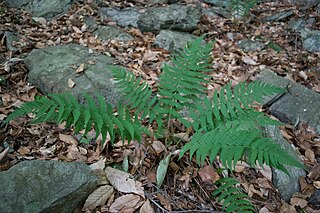
Dryopteris marginalis, vernacularly known as the marginal shield fern or marginal wood fern, is a perennial species of fern found in damp shady areas throughout eastern North America, from Texas to Minnesota and Newfoundland. It favors moderately acid to circumneutral soils in cooler areas but is fairly drought-resistant once established. In the warmer parts of its range, it is most likely to be found on north-facing non-calcareous rock faces. It is common in many altitudes throughout its range, from high ledges to rocky slopes and stream banks. Marginal wood fern's name derives from the fact that the sori are located on the margins, or edges of the leaflets.

Polystichum acrostichoides, commonly denominated Christmas fern, is a perennial, evergreen fern native to eastern North America, from Nova Scotia west to Minnesota and south to Florida and eastern Texas. It is one of the most common ferns in eastern North America, being found in moist and shady habitats in woodlands, stream banks and rocky slopes. The common name derives from the evergreen fronds, which are often still green at Christmas.

Myriopteris covillei, formerly known as Cheilanthes covillei, is a species of cheilanthoid fern known by the common name Coville's lip fern. Coville's lip fern is native to the southwestern United States and Mexico.
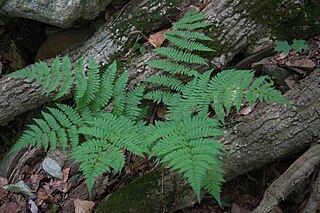
Dryopteris carthusiana is a perennial species of fern native to damp forests throughout the Holarctic Kingdom. It is known as the narrow buckler-fern in the United Kingdom, and as the spinulose woodfern in North America.

Asplenium septentrionale is a species of fern known by the common names northern spleenwort and forked spleenwort. It is native to Europe, Asia and western North America, where it grows on rocks. Its long, slender leaves give it a distinctive appearance. Three subspecies exist, corresponding to a tetraploid and a diploid cytotype and their triploid hybrid.
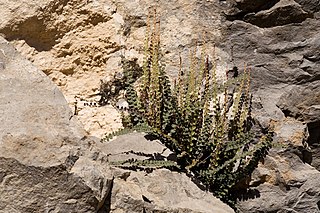
Astrolepis cochisensis is a species of fern known by the common name Cochise scaly cloak fern. It is native to the southwestern United States and northern Mexico, where it occupies mainly desert habitat, often on calcareous soils.
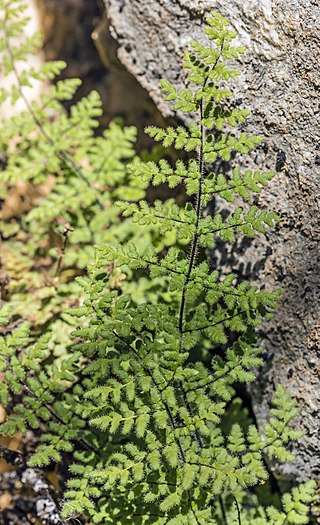
Myriopteris cooperae, formerly Cheilanthes cooperae, is a species of lip fern known by the common name Mrs. Cooper's lip fern, or simply Cooper's lip fern. Its leaves grow in clusters and are highly dissected into oblong segments, rather than the beadlike segments found in some other members of the genus. The axes of the leaves are dark and covered in long, flattened hairs. It is endemic to California, where it grows in rocky habitats, usually over limestone. The species was named in honor of its collector, Sarah Paxson Cooper; according to Daniel Cady Eaton, who described it in 1875, it was the first fern species to be named for a female botanist.

Myriopteris gracillima, formerly known as Cheilanthes gracillima, is a species of lip fern known by the common name lace lip fern. It is native to western North America, where it grows in rocky habitat from British Columbia to California to Montana.
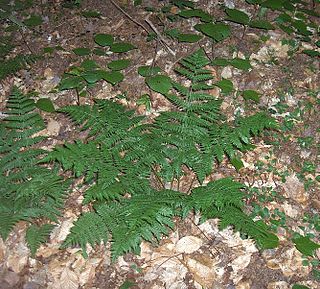
Dryopteris intermedia, the intermediate wood fern or evergreen wood fern, is a perennial, evergreen wood fern native to eastern North America. It is a diploid species, and is the parent of several species of hybrid origin, including Dryopteris carthusiana. Other common names for this species include intermediate shield fern, fancy wood fern, fancy fern, glandular wood fern, American shield fern and common wood fern.

Polystichum californicum is a species of fern known by the common name California sword fern. It is native to western North America from British Columbia to California, where it occurs in the coastal mountain ranges and the Cascade Range through the Sierra Nevada. Its habitat includes forest understory and open rocky slopes. This fern produces several arching or erect leaves up to a meter long. Each lance-shaped leaf is made up of many sharp-toothed segments. The undersides bear rounded sori which contain the spores. This fern arose as a hybrid between other Polystichum species and readily forms hybrids of its own.

Polystichum dudleyi is a species of fern known by the common name Dudley's sword fern. It is endemic to California, where it is known from the forests of the central and southern California Coast Ranges.
Polystichum kruckebergii is a species of fern known by the common names Kruckeberg's sword fern and Kruckeberg's hollyfern. It is native to western North America from Alaska to Utah to California, where it grows in rocky mountain habitat in subalpine and alpine climates.

Polystichum lemmonii is a species of fern known by the common names Lemmon's holly fern and Shasta fern. It is native to western North America from the Sierra Nevada of California north to Washington. It is also known from British Columbia, where there is a single occurrence in the mountains above the Okanagan Valley.

Polystichum lonchitis is a species of fern known by the common name northern hollyfern, or simply holly-fern. It is native to much of the Northern Hemisphere from Eurasia to Alaska to Greenland and south into mountainous central North America. It has stiff, glossy green, erect fronds and grows in moist, shady, rocky mountain habitats.

Polystichum scopulinum is a species of fern known by the common names mountain hollyfern and rock sword fern. It is native to much of western North America, and it is known from disjunct occurrences in eastern Canada as well. It grows in rocky habitat, often in full sun. It is widespread but mostly found in small populations, and is noted to be most abundant on serpentine soils. This fern produces several erect, narrowly lance-shaped leaves up to 50 centimeters in length. The leaves narrow near the bases. Each leaf is divided into many lance-shaped or oblong leaflets up to 3 centimeters long. The toothed leaflets are sometimes twisted on their axes and overlapping.

Diplazium molokaiense is a rare species of fern known by the common name Molokai twinsorus fern. It is endemic to Hawaii, where it is one of the rarest ferns. It has historically been found on the islands of Kauai, Oahu, Lanai, Molokai, and Maui, but it is thought to have been extirpated from four of them and today can be found only on Maui where fewer than 70 individual plants remain. The fern was federally listed as an endangered species of the United States in 1994.
Asplenium × gravesii, commonly known as Graves' spleenwort, is a rare, sterile, hybrid fern, named for Edward Willis Graves (1882–1936). It is formed by the crossing of Bradley's spleenwort (A. bradleyi) with lobed spleenwort (A. pinnatifidum). It is only found where its parent species are both present; in practice, this proves to be a few scattered sites in the Appalachian Mountains, Shawnee Hills, and Ozarks, reaching perhaps its greatest local abundance around Natural Bridge State Resort Park. Like its parents, it prefers to grow in acid soil in the crevices of sandstone cliffs.
Anemia tabascana is a fern endemic to the state of Tabasco, Mexico. It grows on road banks on a single hill in Huimanguillo. Like other members of the genus, its leaves are pinnately divided into a single set of leaflets; in fertile leaves, the lowest pair of leaflets projects at right angles to the rest of the leaf and bears spores. The freely forking veins, which do not rejoin one another after forking, and sparse, rather than abundant, hairs on the leaf axes, distinguish it from similar species in the genus.

